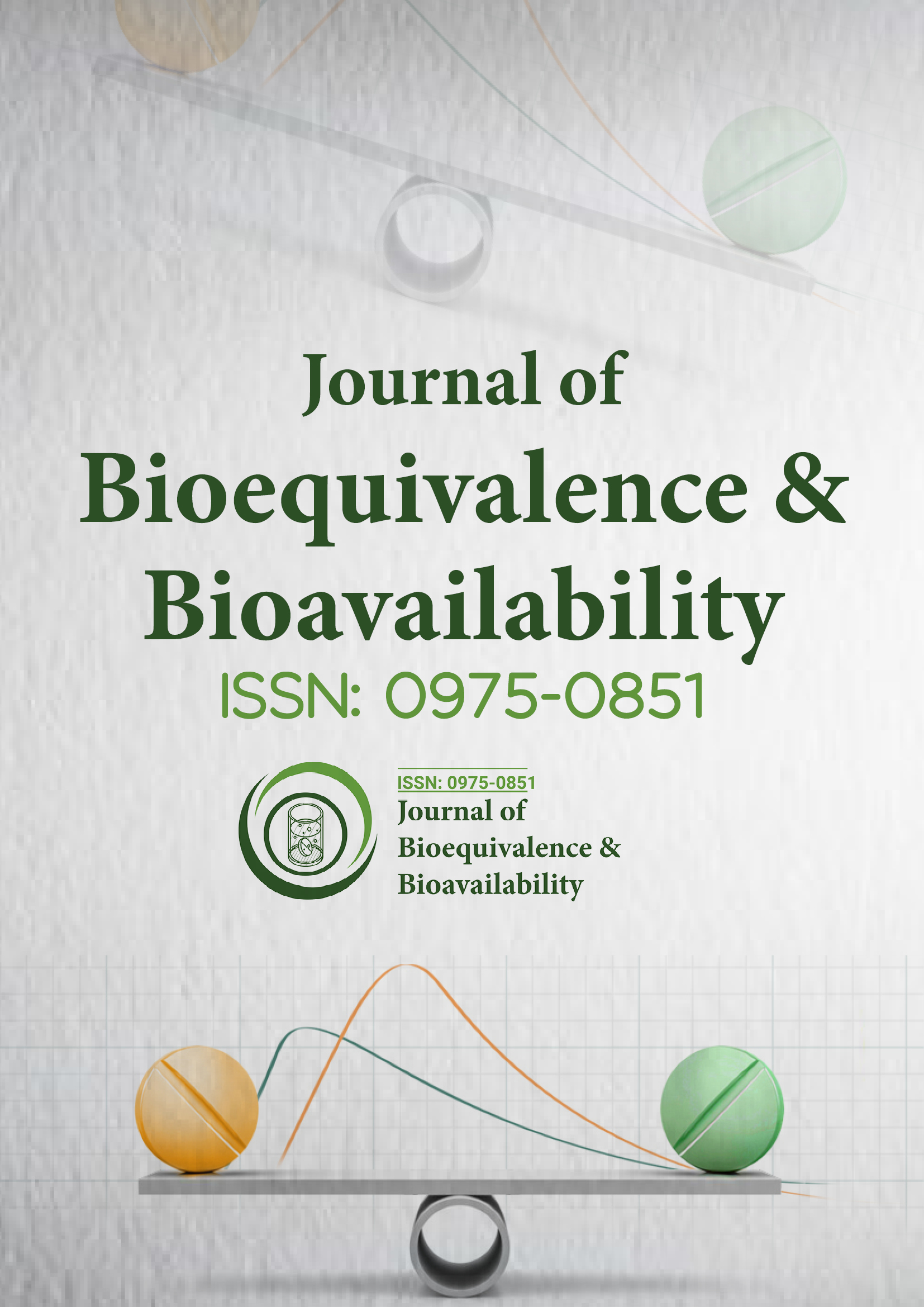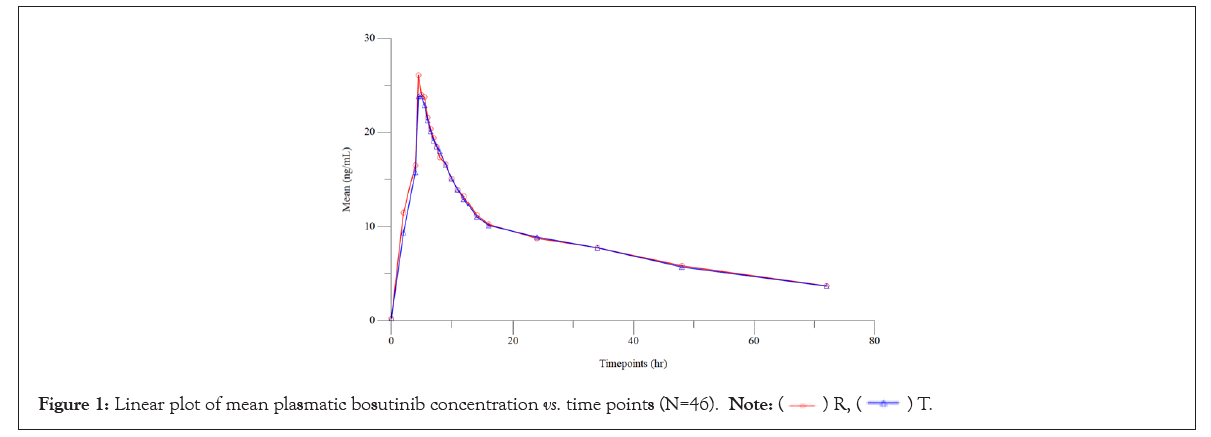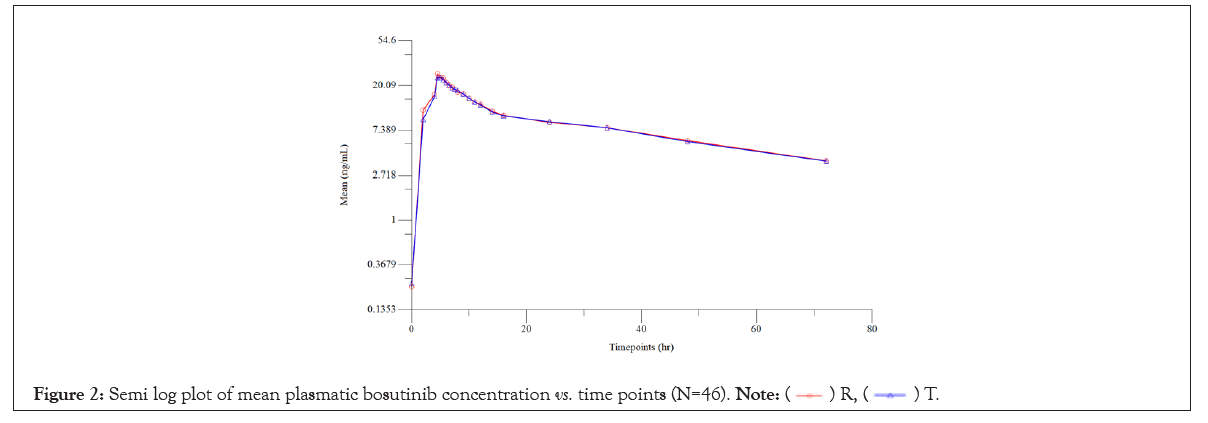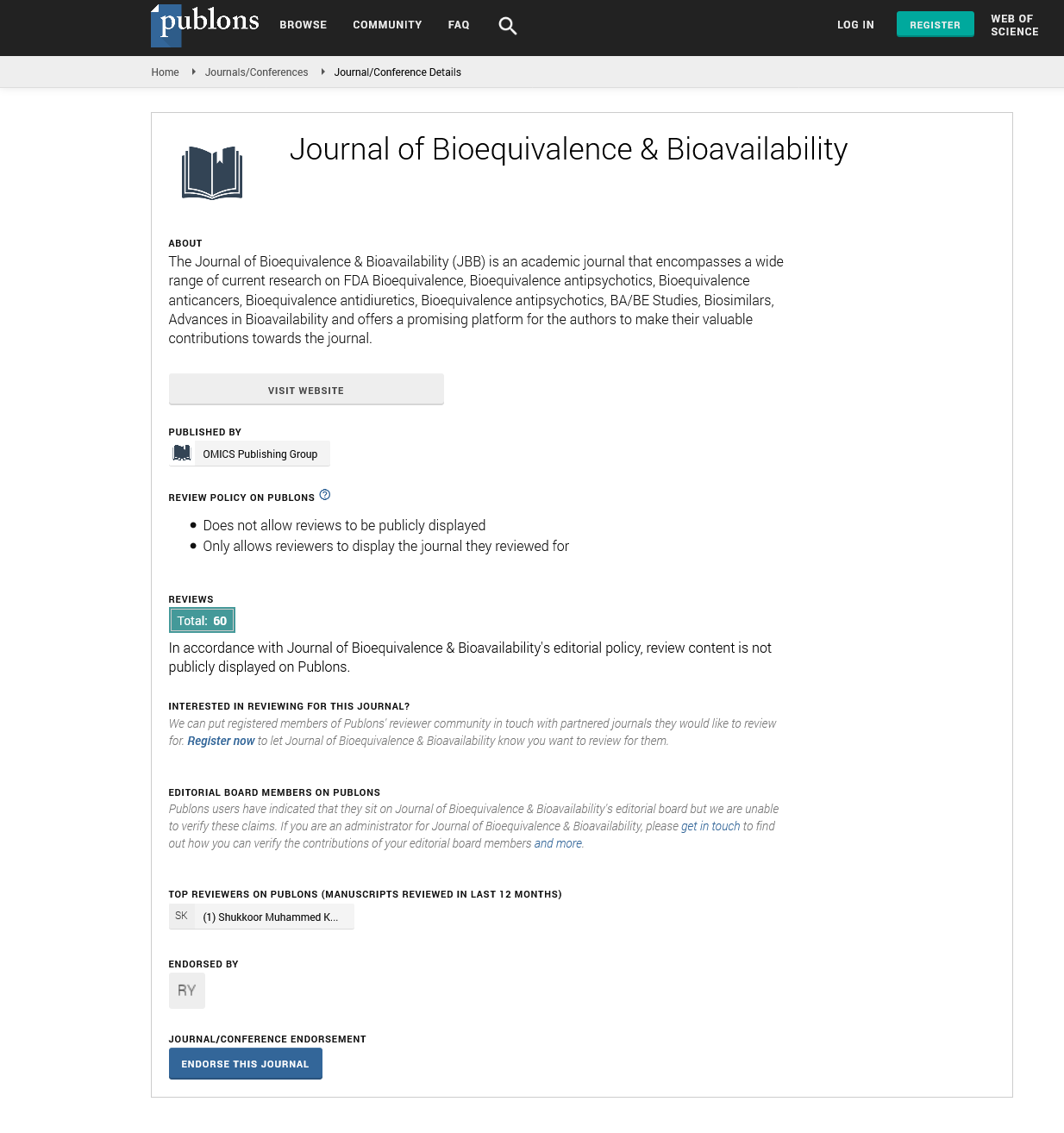Indexed In
- Academic Journals Database
- Open J Gate
- Genamics JournalSeek
- Academic Keys
- JournalTOCs
- China National Knowledge Infrastructure (CNKI)
- CiteFactor
- Scimago
- Ulrich's Periodicals Directory
- Electronic Journals Library
- RefSeek
- Hamdard University
- EBSCO A-Z
- OCLC- WorldCat
- SWB online catalog
- Virtual Library of Biology (vifabio)
- Publons
- MIAR
- University Grants Commission
- Geneva Foundation for Medical Education and Research
- Euro Pub
- Google Scholar
Useful Links
Share This Page
Journal Flyer

Open Access Journals
- Agri and Aquaculture
- Biochemistry
- Bioinformatics & Systems Biology
- Business & Management
- Chemistry
- Clinical Sciences
- Engineering
- Food & Nutrition
- General Science
- Genetics & Molecular Biology
- Immunology & Microbiology
- Medical Sciences
- Neuroscience & Psychology
- Nursing & Health Care
- Pharmaceutical Sciences
Research Article - (2023) Volume 15, Issue 1
An Open Label, Balanced, Randomized, Two Treatments, Two Sequences, Two Periods, Single Dose, Cross Over, Bioequivalence Study of Bosutinib 100 Mg Tablets of Abbott Laboratories Versus Bosulif (Bosutinib) 100 Mg Film Coated Tablets of Pfizer Limited Under Fed Condition in Healthy Subjects
Srinivas Gopineedu1*, Arjun Arumugam O1, Geetha Lakshmi G1, Nageswara Rao T1, Sudipta Basu2, Perez-Perez M2, Hurtado- Colorado Karen2, Gavino-Gutierrez AM2, Claudia Lara2, Higuera MJ2 and Peñaloza I12Abbott Laboratories de Colombia, Bogota, Colombia
Received: 13-Jan-2023, Manuscript No. JBB-23-19583; Editor assigned: 18-Jan-2023, Pre QC No. JBB-23-19583 (PQ); Reviewed: 01-Feb-2023, QC No. JBB-23-19583; Revised: 08-Feb-2023, Manuscript No. JBB-23-19583 (R); Published: 15-Feb-2023, DOI: 10.35428/0975-0851.23.15.498
Abstract
Bosutinib is protein kinase inhibitors that inhibit the abnormal BCR-ABL kinase that promotes CML the treatment of Newly-diagnosed Chronic Phase (CP) Philadelphia Chromosome-Positive Chronic Myelogenous Leukaemia (Ph+ CML). The purpose of this study was to evaluate the bioequivalence between Bosutinib 100 mg tablets of Abbott Laboratories versus Bosulif (Bosutinib) 100 mg film coated tablets of Pfizer Limited in healthy subjects. An open label, balanced, randomized, two treatments, two sequences, two periods, single dose, cross over study with washout period of 07 days under fed condition was carried out in 58 male subjects in the age group of 19 to 44 years who met the study eligibility criteria, participated in the study and 46 subjects completed both periods of the study. The pharmacokinetic samples collected from subjects who completed the study were analyzed to determine the plasma concentration of Bosutinib using bio-analytical method.The 90% confidence interval of AUC0-t and Cmax were 93.65%-101.88% and 86.48%-103.69% respectively which were within the pre-defined acceptable limits and the test product is bioequivalent to the reference product.
Keywords
Bosutinib; Bioavailability; Bioequivalence; Pharmacokinetic
Abbrevations
AEs: Adverse Events; AUC: Area Under the Concentration versus Time Curve; AUC0-t: Area Under the Plasma Concentration versus Time Curve from Zero to Time t; BCR: Breakpoint Cluster Region; BMI: Body Mass Index; CML: Chronic Myelogenous Leukemia; ECG: Electrocardiogram; EMA: European Medicine Agency; FDA: United States Food and Drug Administration; Cmax: Concentration Maximum; CV: Coefficient of Variation; IEC: Independent Ethics Committee; mg: milligram; mL: milliLitre; mM: milli Molar; ng/mL: nano gram per milliLiter; Ph+: Philadelphia Chromosome-Positive; PK: Pharmacokinetic; Tmax: Time Taken to Reach Maximum Concentration.
INTRODUCTION
Many drug patents have recently expired or are scheduled to expire in the near future. In response, many drug manufacturers have expanded their generic drug profile, which requires them to conduct clinical trials that demonstrate that their generic equivalents perform similarly to the innovator drug product [1-6]. Regulations introduced by the United States Food and Drug Administration (USFDA) and the European Medicines Agency (EMA) over the last thirty-five years have strengthened measures to ensure the bioequivalence of drug products, which may be simultaneously manufactured by multiple drug makers [7,4]. Bioequivalence and bioavailability testing standards have also emerged following recognition that bioequivalence and variations in the bioavailability of drug products can result in therapeutic failure and/or toxicity [1, 2, 4-6]. Bosulif (Bosutinib) is tyrosine kinase inhibitors. The active ingredient of Bosulif is Bosutinib monohydrate. Bosutinib inhibits the abnormal BCR-ABL kinase that promotes CML and also inhibits Src family kinases including Src, Lyn and Hck and minimally inhibits Platelet-Derived Growth Factor (PDGF) receptor and c-Kit [8-10]. Each Bosulif tablet contains 100 mg of Bosutinib. Bosutinib is designated chemically as 3-Quinolinecarbonitrile, 4-[(2,4-dichloro-5-methoxyphenyl)amino]-6-methoxy-7-[3-(4-methyl-1-piperazinyl)propoxy]-hydrate (1:1). Its molecular formula is C26H29Cl2N5O3•H2O (monohydrate) and it has a molecular weight of 548.46 (monohydrate), equivalent to 530.46 (anhydrous) [9].
This study was designed to evaluate the relative bioequivalence of the test Bosutinib 100 mg tablets of Abbott Laboratories versus reference Bosulif (Bosutinib) 100 mg film coated tablets of Pfizer Limited under fed condition in healthy subjects [8].
Materials and Methods
Materials
Test product, dose and mode of administration, batch: Bosutinib 100 mg tablets, 01 × 100 mg, Oral with 240 mL of water in sitting posture under fed condition, 21D601.
Reference product, dose and mode of administration, batch: Bosulif (Bosutinib) 100 mg film coated tablets, 01 x 100 mg, Oral with 240 mL of water in sitting posture under fed condition, DW1469.
Methodology
The study protocol with annexes was prepared and IEC approval was obtained before initiation of the study. Study subjects were screened and enrolled in the study as per the IEC approved protocol. Written informed consent was obtained from each volunteer in screening visit to initiation of screening procedure and for the study prior to enrolment. Individual counseling was then given to the willing volunteers by the Investigator in private and any questions and concerns were addressed prior to obtaining consent. The Principal investigator/sub-investigator/physician reviewed all the screening results to assess eligibility of each volunteer. Subjects were enrolled in the study based on the inclusion and exclusion criteria [8].
This study was designed based on the known pharmacokinetic profile of the investigational product and general accepted standards for the conduct of bio-equivalence study [8].
Fifty-eight male subjects were selected, enrolled and randomly assigned to one of the sequences of test products (T) and reference products (R) (TR or RT) for study drug administration. The study was conducted in two groups with 12 subjects (S01-S12) in group 01 and group 02 comprised of 46 subjects (S13-S58).
A washout period of 07 days was maintained between each treatment, in order to minimize any possibility of carryover effect from preceding treatment. The blood samples were collected at pre-defined time intervals for the measurement of concentration and pharmacokinetic parameters of Bosutinib in each period [9].
All the protocol restrictions were respected by the subjects throughout the study. The pharmacokinetic samples collected from 46 study completers were analysed to determine Bosutinib concentrations using a validated bio-analytical method in LCMS/MS.
The pharmacokinetic analysis of Bosutinib was performed using the concentration data obtained for 46 study completers (Tables 1 and 2).
| Parameter | N | Reference (R) (Mean ± SD) |
|---|---|---|
| Cmax (ng/mL) | 46 | 28.571 ± 11.253 |
| AUC0-t (ng.hr/mL) | 46 | 602.247 ± 171.835 |
| AUC0-∞ (ng.hr/mL) | 46 | 805.086 ± 243.687 |
| *Tmax (hr) | 46 | 4.50 (2.00-14.00) |
| T1/2 (hr) | 46 | 37.080 ± 6.580 |
| Kel (hr-1) | 46 | 0.019 ± 0.003 |
| AUC_% Extrap_Obs(%) | 46 | 24.771 ± 5.283 |
Note: *Expressed in terms of median (range)
Table 1: Summary of pharmacokinetic parameters for bosutinib of reference product-R
| Parameter | N | Test (T) (Mean ± SD) |
|---|---|---|
| Cmax (ng/mL) | 46 | 27.386 ± 11.427 |
| AUC0-t (ng.hr/mL) | 46 | 589.517 ± 188.342 |
| AUC0-∞ (ng.hr/mL) | 46 | 793.697 ± 274.887 |
| *Tmax (hr) | 46 | 5.00 (4.50-9.00) |
| T1/2 (hr) | 46 | 36.581 ± 6.389 |
| Kel (hr-1) | 46 | 0.020 ± 0.003 |
| AUC_% Extrap_Obs(%) | 46 | 25.018 ± 5.537 |
Note: *Expressed in terms of median (range)
Table 2: Summary of pharmacokinetic parameters for bosutinib of test product-T
Statistical analysis of Bosutinib was performed considering the pharmacokinetic data of 43 subjects excluding three subjects: S03, S06 and S55 based on the pre-defined protocol criterion.
Bioequivalence was determined by statistical comparison of Ln-transformed data of Cmax and AUC0-t of the test and reference formulations using SAS® version 9.4 (Table 3 and Figures 1 and 2).
| Parameters | Ln AUC0-t | Ln Cmax | |
|---|---|---|---|
| Least Square Mean | Test Product (T) | 574.6076 | 26.0076 |
| Reference Product (R) | 588.2544 | 27.4652 | |
| T/R Ratio (%) | 97.68 | 94.69 | |
| 90% Confidence Interval | 93.65%-101.88% | 86.48%-103.69% | |
| Intra-subject CV (%) | 11.61 | 25.34 | |
| Power (%) | 100 | 99.08 | |
Table 3: Statistical results of test product-t versus reference produc-r for bosutinib (N=43)

Figure 1: Linear plot of mean plasmatic bosutinib concentration vs. time points (N=46). 

Figure 2: Semi log plot of mean plasmatic bosutinib concentration vs. time points (N=46). 
Study Criteria for inclusion/exclusion of subjects
Healthy volunteers, aged 18 to 45 years, and with BMI of 18.50-29.99 Kg/m2 and weight>50 Kg were eligible to be enrolled in the study (Tables 4 and 5).
| Parameter | Mean | SD | Min | Max |
|---|---|---|---|---|
| Age (years) | 33 | 7 | 19 | 44 |
| Height (m) | 1.68 | 0.068 | 1.573 | 1.891 |
| Weight (Kg) | 67.7 | 11 | 50.4 | 98.7 |
| BMI (Kg/m2) | 23.88 | 2.67 | 19.25 | 29.7 |
Table 4: Summarized demographic profile of all subjects enrolled for bosutinib (N=58)
Inclusion criteria encompassed no evidence of cardiac, pulmonary, gastrointestinal, hepatic, renal, hematologic, or neurologic disorders, or any acute or chronic disease, no history of drug or alcohol addiction, normal laboratory tests (complete blood counts, urinalysis, liver and kidney function, and blood sugar); and serological negativity HIV, hepatitis B.
Subjects were informed by an investigator about the purposes and risks of the study. They were asked to abstain from using concomitant medications, including over-the-counter products, dietary supplements and natural products which potentially modify kinetics/dynamics of Bosutinib, 14 days prior to dosing and throughout the end of the study. Consumption of grapefruit and/or its products were not allowed within 10 days prior to the start of the study. Caffeine and/or xanthine-containing products or alcohol were not allowed 48 hours prior the first administration of the study medications and throughout the blood sampling periods.
Sample size and power
A European public assessment report was used as basis for the sample size calculation providing a CV of 30.7% for Cmax and 26.3% for AUC.
Using a CV of 30% for Cmax and an expected mean difference of 5% between the formulations 52 subjects would be required to establish bioequivalence within the BE limits of 80%-125% with a 90% power in a 2 × 2 crossover study. Adding a 10% drop-out rate the sample size increased to 58 subjects.
Subjects drug administration and blood sampling
After an overnight fasting of 10 hours, subjects were provided with high fat high calorie breakfast 30 minutes prior to drug administration, following completion of high fat high calorie breakfast subjects were administered with a single oral dose of either test product or reference product with 240 mL of water as per the randomization schedule in sitting posture at ambient temperature in each period. Compliance to drug administration was assessed by examination of the oral cavity and hands of the subject immediately after dosing.
Subjects were in sitting posture for 02 hours after dosing. During this restriction period, the subjects were permitted to walk for reasons such as but not limited to the following: natural exigencies. Subjects were restricted from consumption of water for 01 hour before and 01 hour after dosing in each period and were allowed to drink water ad libitum thereafter.
The pharmacokinetic profile (in terms of rate and extent of absorption) of both test and reference products was evaluated based on measured concentration of drug in the human plasma samples collected during the clinical phase. Blood samples for pharmacokinetic analysis were designed appropriately for characterizing the pharmacokinetic profile for the given treatments at the dose administered.
A total of 21 blood samples of 04 mL each at 00.00 (Pre-dose), 02.00, 04.00, 04.50, 05.00, 05.50, 06.00, 06.50, 07.00, 07.50, 08.00, 09.00, 10.00, 11.00, 12.00, 14.00, 16.00, 24.00, 34.00, 48.00 and 72.00 hours post dose, were collected for measurement of pharmacokinetic parameters in each period.
Tolerability
Subjects were monitored for Adverse Events (AEs) during both periods of the study. Subjects were instructed to inform clinic personnel of any untoward medical symptoms and/or events that arose during the study. Prior to check in of each period, subjects were questioned concerning unusual symptoms that may have occurred after the previous administration of the study drug. The Principal Investigator/sub-investigator/study physician also evaluated the subjects for subsequent dosing. Each adverse event reported by the subjects during the study was assessed for its seriousness, severity, relationship with the study drug and outcome.
Subject’s Safety was assessed via continuous monitoring and scheduled recording of safety measurements throughout the study through clinical examinations, vital assessment, 12-lead Electrocardiogram (ECG), rapid antigen test for COVID-19, clinical laboratory parameters (e.g., Hematology, Biochemistry, Urine analysis and Serology test) and monitoring subjects’ well-being, symptoms and signs for adverse events.
No serious adverse events were reported during the conduct of this study. A total of 13 non-serious adverse events were reported by 12 subjects during the study. Seven adverse events were reported following administration of the reference product, 05 adverse events with test product and 01 during post study safety assessment.
All AEs reported in the study resolved without sequelae and were assessed to be either mild or moderate in intensity. The incidence of AEs in the study for reference product was (13.46%) and test product was (10.20%).
Among the non-serious AEs reported in the study 04 AEs were probably related, 06 AEs were unrelated and 03 AEs were possibly related to study medications and were expected following exposure to Bosutinib.
Pharmacokinetic and statistical analysis
(Tables 1, 4, 5 and 6, Figures 1 and 2) Pharmacokinetic analysis was performed using the concentration data obtained from 46 subjects who completed both periods of the study.
| Parameter | Mean | SD | Min | Max |
|---|---|---|---|---|
| Age (years) | 33 | 7 | 19 | 44 |
| Height (m) | 1.681 | 0.073 | 1.573 | 1.891 |
| Weight (Kg) | 68.0 | 11.6 | 50.4 | 98.7 |
| BMI (Kg/m2) | 23.92 | 2.73 | 19.47 | 29.7 |
Table 5: Summarized demographic profile of study completers for bosutinib (N=46)
| Parameters | Cmax | AUC0-t | Significance |
|---|---|---|---|
| Sequence effect | 0.2929 | 0.2451 | Insignificant for Cmax and AUC0-t |
| Period effect | 0.026 | <.0001 | Significant for Cmax and AUC0-t |
| Treatment (Formulation) effect | 0.318 | 0.3534 | Insignificant for Cmax and AUC0-t |
| Subjects nested within sequence | <.0001 | <.0001 | Significant for Cmax and AUC0-t |
Note: P<.10 for Sequence effect and P<.05 for all other effects considered to be significant
Table 6: p-Value for Cmax and AUC of Bosutinib
Statistical analysis was performed using the pharmacokinetic data obtained from 43 subjects; three subjects were excluded from statistical analysis for the following reasons:
• S03 and S06 were excluded as both subjects exhibited pre-dose concentration greater than 5% of Cmax of period II. This exclusion of data was based on the pre-defined protocol criterion which states “If the pre-dose concentration is more than 5% of Cmax of the respective period in a subject, the subject will be excluded from the statistical analysis”.
• S55 was excluded as the subject reported emesis within two times the median Tmax in one of the study periods. This exclusion of data from analysis is per the pre-defined protocol criterion which states “Data from a subject, who experience emesis less than or equal to two times the reported Tmax”, will be excluded from statistical analysis.
In order to test the two one-sided tests for bioequivalence, ratio analysis, 90% confidence intervals for the difference between treatments’ least-square mean was calculated for Ln-transformed Cmax and AUC0-t of Bosutinib.
Pharmacokinetic parameters were calculated using non-compartmental model of Phoneix® WinNolin® version 8.1 and statistical analysis was carried out using the SAS® statistical software, version 9.4 of SAS Institute Inc., USA.
The mean, standard deviation, standard error, geometric mean, coefficient of variation, minimum, median, maximum and range were calculated for Cmax, AUC0-t, AUC0-∞, Tmax, T½, Kel and AUCExtrapolation.
Results and Discussion
Fifty-eight male subjects in the age group of 19 to 44 years, who met the study eligibility criteria, participated in the study and 46 subjects completed both periods of the study; twelve subjects were withdrawn from the study for the following reasons:
• S10 was withdrawn from the study as COVID-19 RAT was positive during period I check-in.
• S17 and S21 as both these subjects withdrew their consent from the study due to personal reason during period I check-in.
• Six subjects-S19, S25, S26, S43, S46 and S49 were withdrawn from the study as they were positive for COVID-19 RAT during period II check-in.
• S29 was withdrawn from the study due to medical event (fever) during period I check-in.
• S33 and S47 were withdrawn from the study due to adverse event (Hematochezia) following drug administration in period II and adverse event (Fever) during period II check-in, respectively.
The clinical phase of the study was conducted over a period of 33 days. Blood sampling was done at pre-defined intervals up to 72.00 hours in both periods. The plasma concentrations of Bosutinib were quantified in samples of 46 study completers using a validated bio-analytical method in LC-MS/MS.
The pharmacokinetic analysis of Bosutinib was performed using the concentration data obtained following analysis of 46 study completers.
Statistical analysis of Bosutinib was performed using the pharmacokinetic data obtained from 43 subjects excluding data of 03 subjects.
The 90% confidence interval of AUC0-t and Cmax were 93.65%-101.88% and 86.48%-103.69% respectively, which were within the acceptable limits of 80.00% to 125.00%.
Conclusion
Bioequivalence was demonstrated between Bosutinib 100 mg tablets of Abbott Laboratories versus Bosulif (Bosutinib) 100 mg film coated tablets of Pfizer Limited under fed condition in healthy subjects. The 90% CI of Bosutinib 100 mg tablets was within the acceptable limits of 80.00% to 125.00%. Based on the adverse events and proceeds of the study it can be concluded that the study medications were relatively well tolerated by the study subjects at selected dose level.
Acknowledgements
Bioequivalence was demonstrated between Bosutinib 100 mg tablets of Abbott Laboratories versus Bosulif (Bosutinib) 100 mg film coated tablets of Pfizer Limited under fed condition in healthy subjects.
References
- International Conference on Harmonization. (ICH): Harmonized Tripartite Guideline- Guideline for Good Clinical Practice (GCP)- E6. 2016.
- Structure And Content of Clinical Study Reports E3. Current Step 4 version dated 30 November 1995.
- CDSCO’s New Drugs and Clinical Trials Rules. 2019 G.S.R. 227(E).
- EMA’s Guidance on “Guideline on the Investigation of Bioequivalence”. 2010
- INVIMA’s Resolution 00001124. Ministry of Health and Social Protection. 2016.
- Republic of Colombia.
- 21 Code of Federal Regulations.
- Draft Guidance on Bosutinib Monohydrate.
- Summary of product characteristics of Bosulif (Bosutinib) 100 mg film coated tablets of Pfizer Limited, UK.
- Patient information leaflet of Bosulif (Bosutinib) 100 mg film coated tablets of Pfizer Limited, UK.
Citation: Gopineedu S, Arumugam OA, Lakshmi GG, Rao TN, Basu S, Perez PM, et al. (2023) An Open Label, Balanced, Randomized, Two Treatments, Two Sequences, Two Periods, Single Dose, Cross Over, Bioequivalence Study of Bosutinib 100 Mg Tablets of Abbott Laboratories Versus Bosulif (Bosutinib) 100 Mg Film Coated Tablets of Pfizer Limited Under Fed Condition in Healthy Subjects. J Bioequiv Availab. 15:498
Copyright: © 2023 Gopineedu S, et al. This is an open-access article distributed under the terms of the Creative Commons Attribution License, which permits unrestricted use, distribution, and reproduction in any medium, provided the original author and source are credited.

